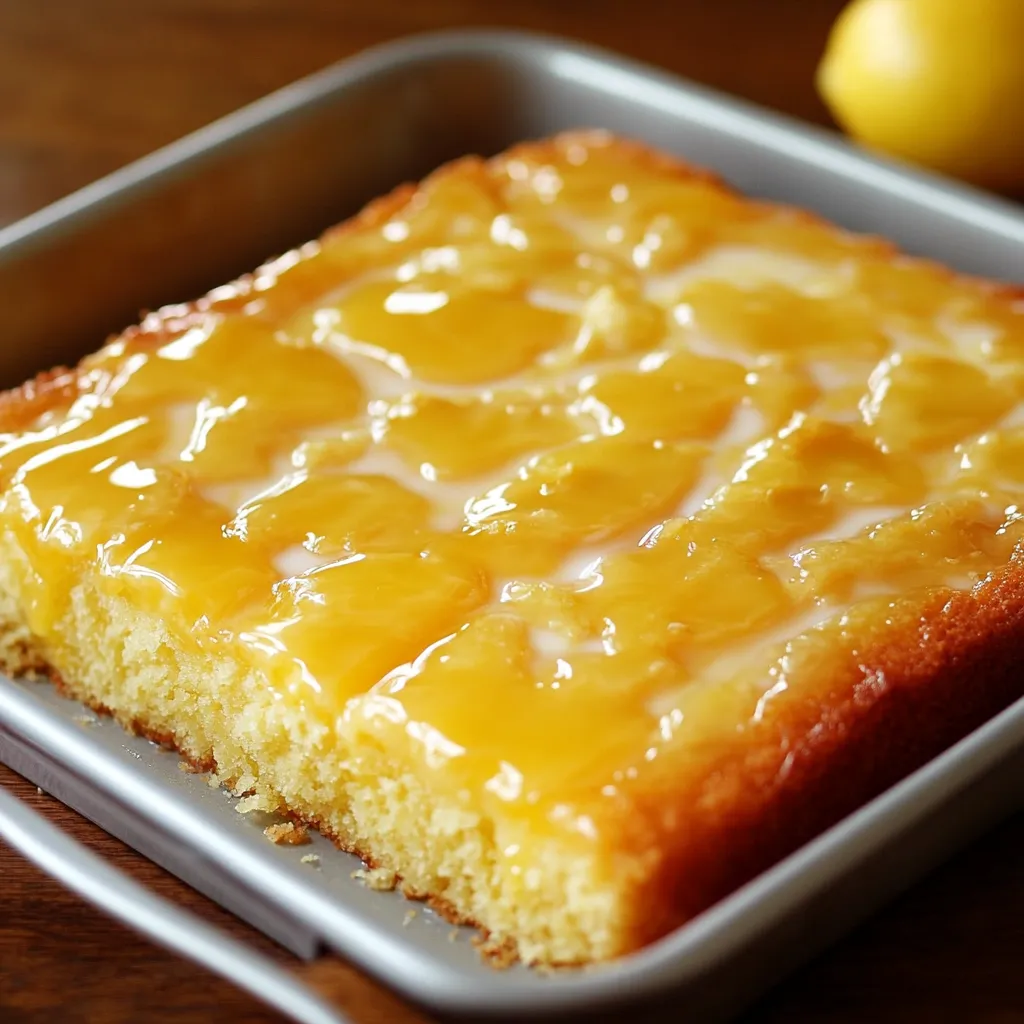When it comes to desserts that are both refreshing and indulgent, lemon cake holds a special place in the hearts of many. The bright, zesty flavor of lemon combined with a soft, moist texture makes it an irresistible treat that can turn any occasion into a celebration. Whether you’re preparing it for a summer picnic, a family gathering, or simply to satisfy a craving, this lemon cake is sure to impress.
This recipe has gained popularity across various occasions, from casual brunches to festive celebrations, because of its simplicity and the burst of flavor it offers. The tangy lemon flavor paired with a sweet, smooth glaze creates a delightful contrast that appeals to all taste buds. In this article, we’ll explore the history and origins of lemon cake, dive into the specifics of the recipe, offer tips on perfecting it, and even discuss some variations to try out.
Overview of the Recipe
Lemon cake is a classic dessert that brings together the best of citrusy freshness and rich, buttery texture. The recipe typically involves a few simple ingredients like yellow cake mix, instant lemon pudding mix, and fresh lemon zest, all of which contribute to its light and airy crumb. What makes this cake truly special is the balance between the tartness of the lemon and the sweetness of the glaze, which seeps into the cake, adding moisture and flavor with every bite.
This cake stands out not just because of its flavor but also due to its ease of preparation. You can whip up the batter in minutes, and the baking process is straightforward, making it an ideal recipe even for beginners. Plus, the versatility of this cake means you can serve it warm or chilled, as a dessert after dinner or a midday snack.
History and Origin of Lemon Cake
Lemons have been used in desserts for centuries, with their origins tracing back to ancient Southeast Asia. The fruit was introduced to the Mediterranean region and eventually became a staple in European cooking, particularly in desserts. The combination of lemon and sugar became a popular way to balance the intense sourness of the lemon, leading to the creation of various lemon-flavored confections.
Over time, lemon cakes evolved from simple, yeast-leavened cakes in medieval times to the more sophisticated sponge cakes we know today. The use of lemon zest and juice in cakes gained popularity in England during the 17th century and spread across Europe and America as a favorite flavoring for cakes and puddings.
In different regions, lemon cake has taken on cultural significance. For instance, in Italy, lemon-flavored desserts like lemon ricotta cake are a common feature of traditional meals, particularly in the southern regions where lemons are abundant.
Ingredients
For the Cake:
- 1 box of yellow cake mix
- 1 small box of instant lemon pudding mix
- ¾ cup of oil
- ¾ cup of water
- 4 beaten eggs
For the Glaze:
- 2 cups of powdered sugar
- 2 tablespoons of melted butter
- 2 tablespoons of water
- ⅓ cup of lemon juice
Instructions
1. Preheat the Oven
Begin by preheating your oven to 350°F (175°C). Grease a 9×13 baking pan to ensure your cake releases easily after baking. Properly preheating the oven is crucial for even baking and achieving that perfect texture.
2. Prepare the Cake Batter
In a large bowl, beat the eggs until well combined. This step ensures that your cake has a light and fluffy texture. Next, add the yellow cake mix, instant lemon pudding mix, oil, and water. Mix everything until smooth and well blended. Be sure to mix until there are no lumps, as this will help the cake rise evenly.
3. Bake the Cake
Pour the batter into the prepared pan. Bake in the preheated oven for 30 to 35 minutes. The cake is done when a toothpick inserted into the center comes out clean. This step is crucial to ensure the cake is fully baked but not overdone. Overbaking can lead to a dry cake, while underbaking can result in a soggy center.
4. Prepare the Glaze
While the cake is baking, prepare the glaze. In a medium bowl, mix together the powdered sugar, lemon juice, and water. Add the melted butter and stir until the mixture is smooth and well combined. The glaze should have a pourable consistency. If it’s too thick, add a little more water; if it’s too thin, add a bit more powdered sugar.
5. Glaze the Cake
Once the cake is baked, remove it from the oven and allow it to cool slightly. Use a wooden spoon to poke holes all over the cake. Pour the lemon glaze evenly over the cake, allowing it to seep into the holes and coat the surface. This step infuses the cake with additional moisture and flavor, making it incredibly delicious.
6. Enjoy
Allow the cake to cool completely before serving. The result is a moist, lemony treat with a deliciously tangy glaze. This cake is best enjoyed at room temperature, but it can also be refrigerated if you prefer a chilled dessert.
Variations of the Recipe
One of the best aspects of a lemon cake is its versatility. You can easily modify the recipe to suit different dietary needs, flavor preferences, and occasions. Here are some delightful variations to consider:
- Gluten-Free Version: For those with gluten sensitivities, making this lemon cake gluten-free is simple. Substitute the yellow cake mix with a gluten-free cake mix. Ensure that the instant lemon pudding mix is also gluten-free, as some brands might contain gluten. The result is just as moist and flavorful, ensuring everyone can enjoy this zesty treat without worry.
- Using Different Citrus Fruits: While lemon is the star of the traditional recipe, experimenting with other citrus fruits can yield equally delicious results. Try using lime for a tart and tangy twist, or orange for a sweeter, milder flavor. Key lime and blood orange are also fantastic options that add unique color and flavor profiles to the cake. For more inspiration, you can explore other citrus-based desserts, which can expand your baking repertoire
- Cupcake Version: Transforming the lemon cake into cupcakes is perfect for serving at parties or as individual treats. Simply divide the batter into a cupcake tin lined with paper cups and reduce the baking time to about 18-22 minutes. Top each cupcake with a dollop of lemon glaze or even a swirl of lemon buttercream for an added layer of indulgence.
- Substituting Ingredients for a Healthier Twist: To make this cake healthier, consider swapping the oil for unsweetened applesauce, which reduces the fat content while keeping the cake moist. You can also use a natural sweetener like honey or maple syrup instead of sugar in the glaze. If you’re looking to cut calories further, replace some of the cake mix with almond flour, which also adds a slight nutty flavor to the cake.
Serving Suggestions
A lemon cake is incredibly versatile when it comes to serving, making it a delightful addition to any occasion. One of the best ways to enjoy this cake is with a warm cup of tea or coffee. The tangy, sweet flavor of the lemon cake pairs beautifully with the rich bitterness of coffee, creating a perfect balance on your palate.
For a more indulgent experience, consider pairing the cake with fresh berries like raspberries, blueberries, or strawberries. The natural sweetness and slight tartness of the berries complement the citrus notes of the cake. A dollop of whipped cream on the side can add a creamy texture that enhances the overall dessert experience.
This cake is also ideal for various occasions. Whether it’s a light dessert after a family dinner, a treat for afternoon tea with friends, or even a centerpiece at a brunch or summer gathering, its bright, refreshing flavor makes it suitable for any event.
Health Benefits and Nutritional Information
While lemon cake is undoubtedly a treat, some of its key ingredients do offer health benefits. Lemons, for instance, are rich in vitamin C, which is essential for boosting the immune system and promoting healthy skin. Additionally, the eggs used in the recipe provide high-quality protein, important for muscle repair and overall health.
However, like many desserts, lemon cake is high in sugar and fat, primarily due to the cake mix and glaze. A typical serving contains around 300-400 calories, with 15-20 grams of fat and 40-50 grams of carbohydrates. This makes it a dessert best enjoyed in moderation.
To make the recipe lighter, consider using a natural sweetener like stevia or reducing the amount of sugar in the glaze. You can also substitute the oil with unsweetened applesauce to lower the fat content.
FAQs
Can I use fresh lemon juice instead of bottled?
Absolutely! Fresh lemon juice offers a more vibrant and authentic citrus flavor, enhancing the overall taste of your cake.
How do I store the cake?
Store the cake in an airtight container at room temperature for up to three days. If you prefer to keep it longer, refrigerate it for up to a week, or freeze it for up to three months. Make sure to thaw it in the fridge overnight before serving.
Can I make the cake ahead of time?
Yes, you can bake the cake in advance. It’s best to add the glaze just before serving to keep the cake moist and fresh. If you’re preparing for a special occasion, you can bake the cake a day or two ahead and store it in the fridge.
What are some substitutes for oil in the recipe?
You can substitute the oil with unsweetened applesauce, Greek yogurt, or even mashed bananas for a healthier option. These substitutes will reduce the fat content while keeping the cake moist.
How do I prevent the cake from becoming too dense?
To avoid a dense cake, be careful not to overmix the batter. Mix just until the ingredients are combined. Also, make sure your baking powder is fresh, as expired leavening agents can lead to a heavy texture.
Common Mistakes to Avoid
Overmixing the batter:
Overmixing can lead to a dense and tough cake. To avoid this, mix the ingredients just until they are combined, which will help maintain a light and airy texture.
Not properly greasing the pan:
Failing to grease your pan thoroughly can cause the cake to stick, making it difficult to remove without breaking. Ensure you grease all sides and corners of the pan or use parchment paper for easy release.
Overbaking the cake:
Overbaking will dry out the cake, stripping it of its moist, tender crumb. To prevent this, start checking the cake a few minutes before the recommended baking time using a toothpick. If it comes out clean, the cake is done.
Inconsistent glaze application:
Pour the glaze over the cake while it’s still warm to allow it to seep into the cake. If applied inconsistently or too late, the glaze might not spread evenly, leading to a less flavorful bite
Conclusion
Creating a lemon cake that truly impresses is simpler than you might think. With its easy preparation and rich, zesty flavor, this cake is a must-try for anyone who loves desserts. Whether you’re a seasoned baker or a beginner, this recipe will guide you to success.
We encourage you to try this recipe and experiment with the variations we’ve suggested. Share your experiences with friends and family—they’re sure to appreciate the delicious results! This lemon cake is not just a treat for the taste buds but also a wonderful way to brighten up any occasion
Print
A Lemon Cake to Die For: A Tangy Delight for Lemon Lovers
- Total Time: 40-45 minutes
- Yield: 12-16 servings
Description
A moist and zesty lemon cake that’s easy to make and topped with a tangy lemon glaze. Perfect for lemon lovers and suitable for various occasions, from family gatherings to potlucks.
Ingredients
For the Cake:
- 1 box of yellow cake mix
- 1 small box of instant lemon pudding mix
- ¾ cup of oil
- ¾ cup of water
- 4 beaten eggs
For the Glaze:
- 2 cups of powdered sugar
- 2 tablespoons of melted butter
- 2 tablespoons of water
- ⅓ cup of lemon juice
Instructions
- Preheat the Oven: Preheat oven to 350°F (175°C). Grease a 9×13 baking pan.
- Prepare the Cake Batter: In a large bowl, beat the eggs. Add the yellow cake mix, instant lemon pudding mix, oil, and water. Mix until smooth.
- Bake the Cake: Pour the batter into the prepared pan. Bake for 30 to 35 minutes, or until a toothpick inserted into the center comes out clean.
- Prepare the Glaze: In a medium bowl, mix powdered sugar, lemon juice, and water. Add melted butter and stir until smooth.
- Glaze the Cake: Remove the cake from the oven and cool slightly. Poke holes in the cake with a wooden spoon and pour the glaze evenly over the top.
- Serve: Allow the cake to cool completely before serving.
Notes
- For an enhanced lemon flavor, consider adding fresh lemon zest to the cake batter.
- Store the cake in an airtight container at room temperature for up to three days, or refrigerate for up to a week.
- The cake can be frozen without the glaze and thawed before glazing.
- Prep Time: 10 minutes
- Cook Time: 30-35 minutes
- Category: Dessert
- Method: Baking
- Cuisine: American
Nutrition
- Sugar: 30g
- Sodium: 350mg
- Fat: 15g
- Saturated Fat: 3g
- Carbohydrates: 45g
- Fiber: 0g
- Protein: 3g
- Cholesterol: 55mg




